formerly eScholarship Editions


|
|
|
|
Your request for similar items found 20 book(s). | Modify Search | Displaying 1 - 20 of 20 book(s) | |
| 1. | 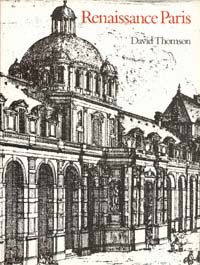 | Title: Renaissance Paris: architecture and growth, 1475-1600 Author: Thomson, David 1912- Published: University of California Press, 1985 Subjects: Art | Architecture Publisher's Description: In the modern literature on Renaissance art and architecture, Paris has often been considered the Cinderella of the European capitals. The prestigious buildings that were erected soon after François I decided in 1528 to make Paris his residence have long since been lost. Thomson, however, restores t . . . [more] Similar Items |
| 2. | 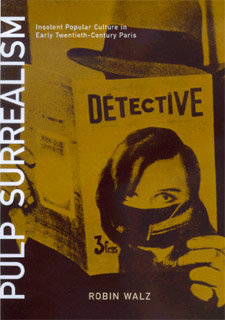 | Title: Pulp surrealism: insolent popular culture in early twentieth-century Paris Author: Walz, Robin 1957- Published: University of California Press, 2000 Subjects: History | French Studies | Comparative Literature Publisher's Description: In addition to its more well known literary and artistic origins, the French surrealist movement drew inspiration from currents of psychological anxiety and rebellion running through a shadowy side of mass culture, specifically in fantastic popular fiction and sensationalistic journalism. The provocative nature of this insolent mass culture resonated with the intellectual and political preoccupations of the surrealists, as Robin Walz demonstrates in this fascinating study. Pulp Surrealism weaves an interpretative history of the intersection between mass print culture and surrealism, re-evaluating both our understanding of mass culture in early twentieth-century Paris and the revolutionary aims of the surrealist movement. Pulp Surrealism presents four case studies, each exploring the out-of the-way and impertinent elements which inspired the surrealists. Walz discusses Louis Aragon's Le paysan de Paris, one of the great surrealist novels of Paris. He goes on to consider the popular series of Fantômes crime novels; the Parisan press coverage of the arrest, trial, and execution of mass-murderer Landru; and the surrealist inquiry "Is Suicide a Solution?", which Walz juxtaposes with reprints of actual suicide faits divers (sensationalist newspaper blurbs). Although surrealist interest in sensationalist popular culture eventually waned, this exploration of mass print culture as one of the cultural milieux from which surrealism emerged ultimately calls into question assumptions about the avant-garde origins of modernism itself. [brief] Similar Items |
| 3. | 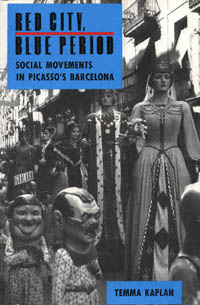 | Title: Red city, blue period: social movements in Picasso's Barcelona Author: Kaplan, Temma 1942- Published: University of California Press, 1992 Subjects: History | Art | European History | Cultural Anthropology | Gender Studies | Art History Publisher's Description: In Red City, Blue Period , Kaplan combines the methods of anthropology and the new cultural history to examine the civic culture of Barcelona between 1888 and 1939. She analyzes the peculiar sense of solidarity the citizens forged and explains why shared experiences of civic culture and pageantry sometimes galvanized resistance to authoritarian national governments but could not always overcome local class and gender struggles. She sheds light on the process by which principles of regional freedom and economic equity developed and changed in a city long known for its commitment to human dignity and artistic achievement.Although scholars increasingly recognize the relationship between so-called high art and popular culture, little has been done to explain what opens the eyes of artists to folk figures and religious art. Kaplan shows how artists like Picasso and Joan Miró, playwright Santiago Russinyol, the cellist Pablo Casals, and the architect Antonio Gaudí, as well as anarchists and other political activists, both shaped and were influenced by the artistic and political culture of Barcelona. [brief] Similar Items |
| 4. | 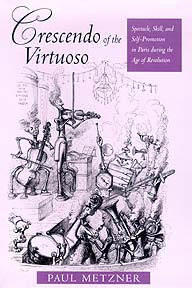 | Title: Crescendo of the virtuoso: spectacle, skill, and self-promotion in Paris during the Age of Revolution Author: Metzner, Paul 1952- Published: University of California Press, 1998 Subjects: History | European History | French Studies | European Studies Publisher's Description: During the Age of Revolution, Paris came alive with wildly popular virtuoso performances. Whether the performers were musicians or chefs, chess players or detectives, these virtuosos transformed their technical skills into dramatic spectacles, presenting the marvelous and the outré for spellbound audiences. Who these characters were, how they attained their fame, and why Paris became the focal point of their activities is the subject of Paul Metzner's absorbing study. Covering the years 1775 to 1850, Metzner describes the careers of a handful of virtuosos: chess masters who played several games at once; a chef who sculpted hundreds of four-foot-tall architectural fantasies in sugar; the first police detective, whose memoirs inspired the invention of the detective story; a violinist who played whole pieces on a single string. He examines these virtuosos as a group in the context of the society that was then the capital of Western civilization. [brief] Similar Items |
| 5. | 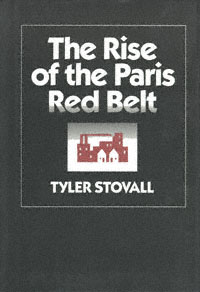 | Title: The rise of the Paris red belt Author: Stovall, Tyler Edward Published: University of California Press, 1990 Subjects: History | European History | Social Science | French Studies Publisher's Description: From 1920 until the present, the working-class suburbs of Paris, known as the Red Belt, have constituted the heart of French Communism, providing the Party not only with its most solid electoral base but with much of its cultural identity as well. Focusing on the northeastern suburb of Bobigny, Stovall explores the nature of working-class life and politicization as he skillfully documents how this unique region and political culture came into being. The Rise of the Paris Red Belt reveals that the very process of urban development in metropolitan Paris and the suburbs provided the most important opportunities for the local establishment of Communist influence.The rapid increase in Paris' suburban population during the early twentieth century outstripped the development of the local urban infrastructure. Consequently, many of these suburbs, often represented to their new residents as charming country villages, soon degenerated into suburban slums. Stovall argues that Communists forged a powerful political block by mobilizing the disillusionment and by improving some of the worst aspects of suburban life.As a social history of twentieth-century France, The Rise of the Paris Red Belt calls into question traditional assumptions about the history of both French Communism and the French working-class. It suggests that those interested in working-class politics, especially in the twentieth century, should consider the significance of residential and consumer issues as well as those relating to the workplace. It also suggests that urban history and urban development should not be considered autonomous phenomena, but rather expressions of class relations. The Rise of the Paris Red Belt brings to life a world whose citizens, though often overlooked, are nonetheless the history of modern France. [brief] Similar Items |
| 6. | 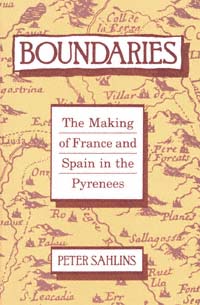 | Title: Boundaries: the making of France and Spain in the Pyrenees Author: Sahlins, Peter Published: University of California Press, 1989 Subjects: History | Anthropology | European History | Geography | French Studies Similar Items |
| 7. | 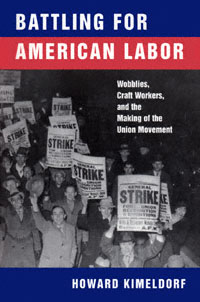 | Title: Battling for American labor: wobblies, craft workers, and the making of the union movement Author: Kimeldorf, Howard Published: University of California Press, 1999 Subjects: American Studies | Sociology | History | United States History | Labor Studies Publisher's Description: In this incisive reinterpretation of the history of the American labor movement, Howard Kimeldorf challenges received thinking about rank-and-file workers and the character of their unions. Battling for American Labor answers the baffling question of how, while mounting some of the most aggressive challenges to employing classes anywhere in the world, organized labor in the United States has warmly embraced the capitalist system of which they are a part. Rejecting conventional understandings of American unionism, Kimeldorf argues that what has long been the hallmark of organized labor in the United States - its distinctive reliance on worker self-organization and direct economic action - can be seen as a particular kind of syndicalism.Kimeldorf brings this syndicalism to life through two rich and compelling case studies of unionization efforts by Philadelphia longshoremen and New York City culinary workers during the opening decades of the twentieth century. He shows how these workers, initially affiliated with the radical IWW and later the conservative AFL, pursued a common logic of collective action at the point of production that largely dictated their choice of unions. Elegantly written and deeply engaging, Battling for American Labor offers insights not only into how the American labor movement got to where it is today, but how it might possibly reinvent itself in the years ahead. [brief] Similar Items |
| 8. | 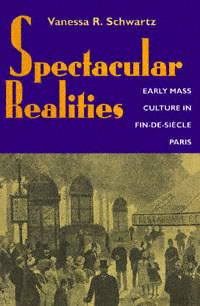 | Title: Spectacular realities: early mass culture in fin-de-siècle Paris Author: Schwartz, Vanessa R Published: University of California Press, 1998 Subjects: History | French Studies | European History | European Literature | Women's Studies | Film Publisher's Description: During the second half of the nineteenth century, Paris emerged as the entertainment capital of the world. The sparkling redesigned city fostered a culture of energetic crowd-pleasing and multi-sensory amusements that would apprehend and represent real life as spectacle.Vanessa R. Schwartz examines the explosive popularity of such phenomena as the boulevards, the mass press, public displays of corpses at the morgue, wax museums, panoramas, and early film. Drawing on a wide range of written and visual materials, including private and business archives, and working at the intersections of art history, literature, and cinema studies, Schwartz argues that "spectacular realities" are part of the foundation of modern mass society. She refutes the notion that modern life produced an unending parade of distractions leading to alienation, and instead suggests that crowds gathered not as dislocated spectators but as members of a new kind of crowd, one united in pleasure rather than protest. [brief] Similar Items |
| 9. | 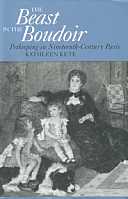 | Title: The beast in the boudoir: petkeeping in nineteenth-century Paris Author: Kete, Kathleen Published: University of California Press, 1994 Subjects: History | European History | French Studies | European Studies Publisher's Description: Kathleen Kete's wise and witty examination of petkeeping in nineteenth-century Paris provides a unique window through which to view the lives of ordinary French people. She demonstrates how that cliché of modern life, the family dog, reveals the tensions that modernity created for the Parisian bourgeoisie.Kete's study draws on a range of literary and archival sources, from dog-care books to veterinarians's records to Dumas's musings on his cat. The fad for aquariums, attitudes toward vivisection, the dread of rabies, the development of dog breeding - all are shown to reflect the ways middle-class people thought about their lives. Petkeeping, says Kete, was a way to imagine a better, more manageable version of the world - it relieved the pressures of contemporary life and improvised solutions to the intractable mesh that was post-Enlightenment France. The faithful, affectionate family dog became a counterpoint to the isolation of individualism and lack of community in urban life. By century's end, however, animals no longer represented the human condition with such potency, and even the irascible, autonomous cat had been rehabilitated into a creature of fidelity and affection.Full of fascinating details, this innovative book will contribute to the way we understand culture and the creation of class. [brief] Similar Items |
| 10. | 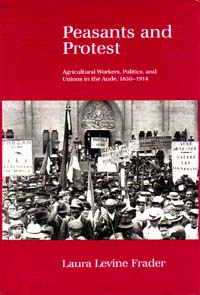 | Title: Peasants and protest: agricultural workers, politics, and unions in the Aude, 1850-1914 Author: Frader, Laura Levine 1945- Published: University of California Press, 1991 Subjects: History | European History | Gender Studies | French Studies Publisher's Description: In the first decade of the twentieth century, the sleepy vineyard towns of the Aude department of southern France exploded with strikes and protests. Agricultural workers joined labor unions, the Socialist party established a base among peasant vinegrowers, and the largest peasant uprising of twentieth-century France, the great vinegrowers' revolt of 1907, shook the entire south with massive demonstrations. In this study, Laura Levine Frader explains how left-wing politics and labor radicalism in the Aude emerged from the economic and social transformation of rural society between 1850 and 1914. She describes the formation of an agricultural wage-earning class, and discusses how socialism and a revolutionary syndicalist labor movement together forged working-class identity.Frader's focus on the making of the rural proletariat takes the study of class formation out of the towns and cities and into the countryside. Frader emphasizes the complexity of social structure and political life in the Aude, describing the interaction of productive relations, the gender division of labor, community solidarities, and class alliances. Her analysis raises questions about the applicability of an urban, industrial model of class formation to rural society. This study will be of interest to French social historians, agricultural historians, and those interested in the relationship between capitalism, class formation, and labor militancy. [brief] Similar Items |
| 11. | 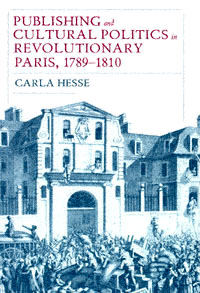 | Title: Publishing and cultural politics in revolutionary Paris, 1789-1810 Author: Hesse, Carla Published: University of California Press, 1991 Subjects: History | European History | Print Media | French Studies Publisher's Description: In 1789 French revolutionaries initiated a cultural experiment that radically transformed the most basic elements of French literary civilization - authorship, printing, and publishing. In a panoramic analysis, Carla Hesse tells how the Revolution shook the Parisian printing and publishing world from top to bottom, liberating the trade from absolutist institutions and inaugurating a free-market exchange of ideas.Historians and literary critics have traditionally viewed the French Revolution as a catastrophe for French literary culture. Combing through extensive new archival sources, Hesse finds instead that revolutionaries intentionally dismantled the elite literary civilization of the Old Regime to create unprecedented access to the printed word. Exploring the uncharted terrains of popular fiction, authors' rights, and literary life under the Terror, Carla Hesse offers a new perspective on the relationship between democratic revolutions and modern cultural life. [brief] Similar Items |
| 12. | 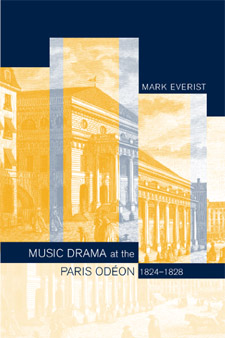 | Title: Music drama at the Paris Odéon, 1824-1828 Author: Everist, Mark Published: University of California Press, 2002 Subjects: Music | Musicology | Opera | French Studies | European History Publisher's Description: Parisian theatrical, artistic, social, and political life comes alive in Mark Everist's impressive institutional history of the Paris Odéon, an opera house that flourished during the Bourbon Restoration. Everist traces the complete arc of the Odéon's short but highly successful life from ascent to triumph, decline, and closure. He outlines the role it played in expanding operatic repertoire and in changing the face of musical life in Paris. Everist reconstructs the political power structures that controlled the world of Parisian music drama, the internal administration of the theater, and its relationship with composers and librettists, and with the city of Paris itself. His rich depiction of French cultural life and the artistic contexts that allowed the Odéon to flourish highlights the benefit of close and innovative examination of society's institutions. [brief] Similar Items |
| 13. |  | Title: Barcelona and beyond: the Disputation of 1263 and its aftermath Author: Chazan, Robert Published: University of California Press, 1992 Subjects: Jewish Studies | Medieval History | Religion Publisher's Description: In late July 1263 a public disputation was convened by King James I of Aragon, pitting Friar Paul Christian against the distinguished rabbi of Gerona, Moses ben Nahman. Organized by leading figures in the Dominican Order to give Friar Paul an opportunity to test his innovative missionizing argumentation against a worthy opponent, the spectacle in Barcelona was colorful, impressive, surely somewhat frightening to the Jews, and ultimately indecisive. Both sides claimed victory, and their documented claims have given rise to substantial disagreement among historians over the tone and outcome of this important event.Robert Chazan's masterly analysis reconstructs the Barcelona disputation from the conflicting Christian and Jewish sources and sets it in its broad historical context, with particular attention to the post-disputation maneuvers on both sides. His richly detailed account focuses on Rabbi ben Nahman's eloquent efforts to reassure his fellow Jews in the face of new missionizing pressures. [brief] Similar Items |
| 14. | 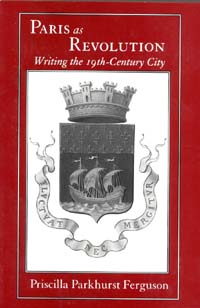 | Title: Paris as revolution: writing in the nineteenth-century city Author: Ferguson, Priscilla Parkhurst Published: University of California Press, 1997 Subjects: Literature | Social Theory | European Literature | Literary Theory and Criticism | European History | French Studies Publisher's Description: In nineteenth-century Paris, passionate involvement with revolution turned the city into an engrossing object of cultural speculation. For writers caught between an explosive past and a bewildering future, revolution offered a virtuoso metaphor by which the city could be known and a vital principle through which it could be portrayed.In this engaging book, Priscilla Ferguson locates the originality and modernity of nineteenth-century French literature in the intersection of the city with revolution. A cultural geography, Paris as Revolution "reads" the nineteenth-century city not in literary works alone but across a broad spectrum of urban icons and narratives. Ferguson moves easily between literary and cultural history and between semiotic and sociological analysis to underscore the movement and change that fueled the powerful narratives defining the century, the city, and their literature. In her understanding and reconstruction of the guidebooks of Mercier, Hugo, Vallès, and others, alongside the novels of Flaubert, Hugo, Vallès, and Zola, Ferguson reveals that these works are themselves revolutionary performances, ones that challenged the modernizing city even as they transcribed its emergence. [brief] Similar Items |
| 15. | 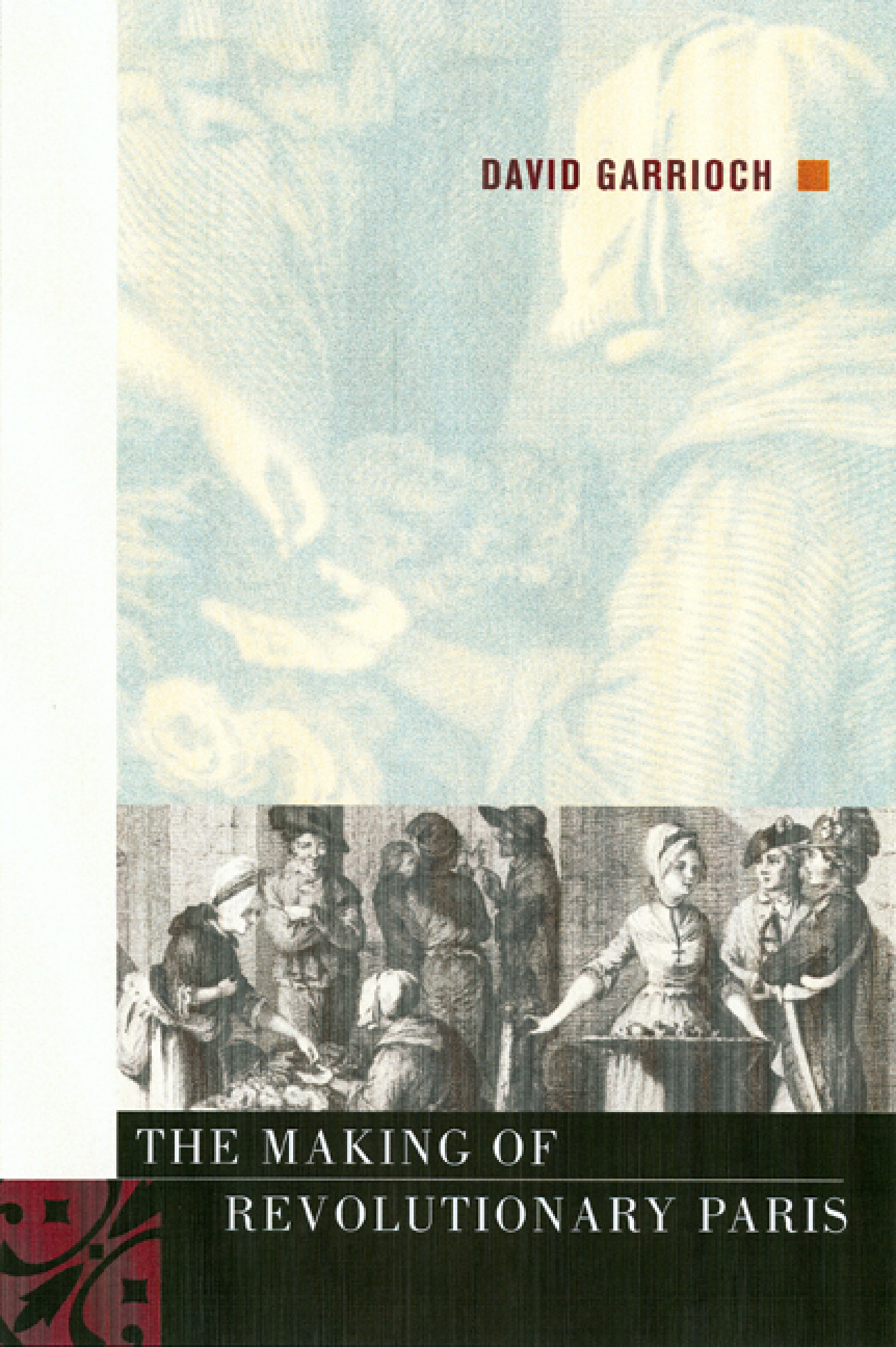 | Title: The making of revolutionary Paris Author: Garrioch, David Published: University of California Press, 2002 Subjects: History | European History | European Studies | French Studies Publisher's Description: The sights, sounds, and smells of life on the streets and in the houses of eighteenth-century Paris rise from the pages of this marvelously anecdotal chronicle of a perpetually alluring city during one hundred years of extraordinary social and cultural change. An excellent general history as well as an innovative synthesis of new research, The Making of Revolutionary Paris combines vivid portraits of individual lives, accounts of social trends, and analyses of significant events as it explores the evolution of Parisian society during the eighteenth century and reveals the city's pivotal role in shaping the French Revolution. David Garrioch rewrites the origins of the Parisian Revolution as the story of an urban metamorphosis stimulated by factors such as the spread of the Enlightenment, the growth of consumerism, and new ideas about urban space. With an eye on the broad social trends emerging during the century, he focuses his narrative on such humble but fascinating aspects of daily life as traffic congestion, a controversy over the renumbering of houses, and the ever-present dilemma of where to bury the dead. He describes changes in family life and women's social status, in religion, in the literary imagination, and in politics. Paris played a significant role in sparking the French Revolution, and in turn, the Revolution changed the city, not only its political structures but also its social organization, gender ideologies, and cultural practices. This book is the first to look comprehensively at the effect of the Revolution on city life. Based on the author's own research in Paris and on the most current scholarship, this absorbing book takes French history in new directions, providing a new understanding of the Parisian and the European past. [brief] Similar Items |
| 16. | 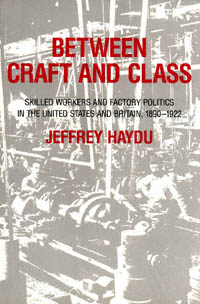 | Title: Between craft and class: skilled workers and factory politics in the United States and Britain, 1890-1922 Author: Haydu, Jeffrey Published: University of California Press, 1991 Subjects: Sociology | United States History | European History | Labor Studies | Technology and Society Publisher's Description: Between Craft and Class provides an incisive new look at workers' responses to the momentous economic changes surrounding them in the early years of the twentieth century. In this work, Haydu focuses on the reaction of skilled metal workers to new production methods that threatened time-honored craft traditions. He finds that the workers' responses to industrial change varied - some defended the status quo, while others agreed to trade customary rules for economic rewards. Under some conditions class protest arose, as workers of diverse skills and trades joined to demand a greater voice in the management of industry. Between Craft and Class explores how broadly based movements for workers' control developed during this critical period, and why they ultimately failed.Comparing workers in the United States and Britain, Haydu's scholarship is distinguished by extensive primary source research and provocative theoretical insights. In its scope and depth, this book will revise current notions of craft politics and working-class radicalism during this period. [brief] Similar Items |
| 17. | 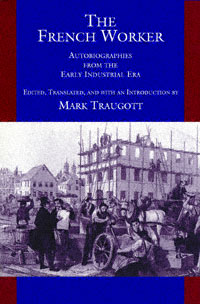 | Title: The French worker: autobiographies from the early industrial era Author: Traugott, Mark Published: University of California Press, 1993 Subjects: History | Sociology | European History | Gender Studies | French Studies Publisher's Description: This anthology, drawn from the autobiographies of seven men and women whose lives span the nineteenth century, provides a rare glimpse of the everyday lives of workers in the age of early industrialization in France. Appearing for the first time in English, these stories vividly convey the ambitions, hardships, and reversals of ordinary people struggling to gain a measure of respectability.The workers' livelihoods are diverse: chair-maker, embroiderer, joiner, mason, silk weaver, machinist, seamstress. Their stories of daily activities, work life, and popular politics are filled with lively, often poignant moments. We learn of dismal, unsanitary housing; of disease; workplace accidents; and terrible hardship, especially for the children of the poor. We read of exploitation and injustice, of courtship and marriage, and of the sociability of the wine-merchant's shop and the boardinghouse.Traugott's analytic introduction discusses the many shifts in French society during the nineteenth century. Used in combination with other sources, these autobiographies illuminate the relationship between changes in working conditions and in the forms of political participation and protest occurring as the century came to a close. [brief] Similar Items |
| 18. | 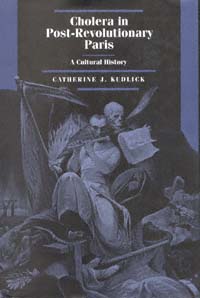 | Title: Cholera in post-revolutionary Paris: a cultural history Author: Kudlick, Catherine Jean Published: University of California Press, 1996 Subjects: History | European History | Medicine Publisher's Description: Cholera terrified and fascinated nineteenth-century Europeans more than any other modern disease. Its symptoms were gruesome, its sources were mysterious, and it tended to strike poor neighborhoods hardest. In this insightful cultural history, Catherine Kudlick explores the dynamics of class relations through an investigation of the responses to two cholera epidemics in Paris.While Paris climbed toward the height of its urban and industrial growth, two outbreaks of the disease ravaged the capital, one in 1832, the other in 1849. Despite the similarity of the epidemics, the first outbreak was met with general frenzy and far greater attention in the press, popular literature and personal accounts, while the second was greeted with relative silence. Finding no compelling evidence for improved medical knowledge, changes in the Paris environment, or desensitization of Parisians, Kudlick looks to the evolution of the French revolutionary tradition and the emergence of the Parisian bourgeoisie for answers. [brief] Similar Items |
| 19. | 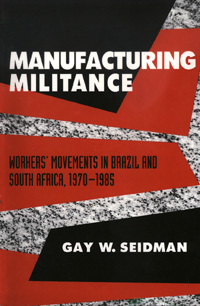 | Title: Manufacturing militance: workers' movements in Brazil and South Africa, 1970-1985 Author: Seidman, G Published: University of California Press, 1994 Subjects: Politics | Latin American Studies | African Studies | Labor Studies | Economics and Business Publisher's Description: Challenging prevailing theories of development and labor, Gay Seidman's controversial study explores how highly politicized labor movements could arise simultaneously in Brazil and South Africa, two starkly different societies. Beginning with the 1960s, Seidman shows how both authoritarian states promoted specific rapid-industrialization strategies, in the process reshaping the working class and altering relationships between business and the state. When economic growth slowed in the 1970s, workers in these countries challenged social and political repression; by the mid-1980s, they had become major voices in the transition from authoritarian rule.Based in factories and working-class communities, these movements enjoyed broad support as they fought for improved social services, land reform, expanding electoral participation, and racial integration.In Brazil, Seidman takes us from the shopfloor, where disenfranchized workers organized for better wages and working conditions, to the strikes and protests that spread to local communities. Similar demands for radical change emerged in South Africa, where community groups in black townships joined organized labor in a challenge to minority rule that linked class consciousness to racial oppression. Seidman details the complex dynamics of these militant movements and develops a broad analysis of how newly industrializing countries shape the opportunities for labor to express demands. Her work will be welcomed by those interested in labor studies, social theory, and the politics of newly industrializing regions. [brief] Similar Items |
| 20. | 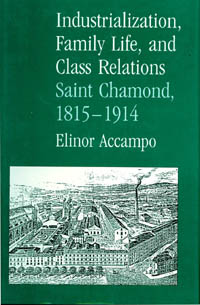 | Title: Industrialization, family life, and class relations: Saint Chamond, 1815-1914 Author: Accampo, Elinor Ann Published: University of California Press, 1989 Subjects: History | European History | Women's Studies Publisher's Description: In this provocative study, Elinor Accampo explores the interrelationship between the structure of work and strategies of family formation in Saint Chamond, a French city that underwent intensive industrialization during the nineteenth century. Through a detailed analysis of fertility, mortality, marriages, and migration, the author analyzes the ways in which the family responded to changes in the organization of work. In the first half of the nineteenth century work was in the home, and families tended to be large in order to meet the demand for workers. But by the 1860s the mechanization of labor had begun to separate family life and work life, fundamentally transforming the relationship between work and family and making the survival of the working-class family more difficult. Accampo argues that workers began to have smaller families much earlier than has previously been suggested, and she demonstrates that fertility declined for reasons unique to working-class conditions. This decline in family size, and the context in which it took place, provides fascinating new material for understanding the working class world and the dynamics of class relations. [brief] Similar Items |